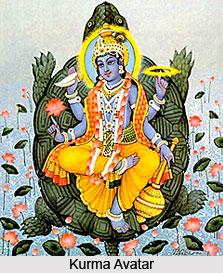 Content of Kurma Purana comprises a description of the exploits of Lord Vishnu in the Kurma avatar. This work begins with a hymn to the incarnation of Vishnu as Kurma (tortoise) on which the mountain Mandara rested when the ocean was twirled. At that time Goddess Lakshmi arose from the ocean and became Vishnu`s consort. When the Rishis ask him who this goddess is, Vishnu replies that she is his highest Sakti. The Introduction then relates further how Indradyumna, who in a former birth had been a king, but was born again as a Brahmin by reason of his devotion to Vishnu, desired to gain knowledge of the glory of Lord Shiva. Lakshmi refers him to Vishnu. Then he worships Vishnu as the Universal God, the Creator and Preserver of the universe, but also as "Mahadeva," "Shiva" and as "father and mother of all beings." At length, Vishnu, in his incarnation as the tortoise, imparts the Purana to him.
Content of Kurma Purana comprises a description of the exploits of Lord Vishnu in the Kurma avatar. This work begins with a hymn to the incarnation of Vishnu as Kurma (tortoise) on which the mountain Mandara rested when the ocean was twirled. At that time Goddess Lakshmi arose from the ocean and became Vishnu`s consort. When the Rishis ask him who this goddess is, Vishnu replies that she is his highest Sakti. The Introduction then relates further how Indradyumna, who in a former birth had been a king, but was born again as a Brahmin by reason of his devotion to Vishnu, desired to gain knowledge of the glory of Lord Shiva. Lakshmi refers him to Vishnu. Then he worships Vishnu as the Universal God, the Creator and Preserver of the universe, but also as "Mahadeva," "Shiva" and as "father and mother of all beings." At length, Vishnu, in his incarnation as the tortoise, imparts the Purana to him.
As in this Introduction, Shiva is the Highest Being throughout the work, but it is emphasized over and over again that in reality Brahma, Vishnu and Shiva are one. The worship of Sakti, i.e. "Energy" or "Creative force" conceived as a female deity, is also emphasized. In like manner as Vishnu is none other than Shiva, Lakshmi, and Sakti, is in reality not apart from the Devi.
When a decision regarding as to which god was the more worthy of worship, Vishnu or Shiva, the seven Rishis decided the dispute by declaring that the deity worshipped by any man is that man`s deity, and that all the gods deserve the worship of at least some beings. Notwithstanding Siva is the god above all gods to such a degree that, though Krishna is praised as Vishnu Narayana, he obtains a son for his wife Jambavati only after strenuous asceticism and by the mercy of Shiva.
The five themes of the Puranas, namely the Creation, the genealogies etc, are also treated in the Kurma Purana, and in this connection a few of Vishnu`s Avataras are touched upon. However, an entire chapter is devoted to the incarnations of Shiva. A considerable section of the first part consists of a description and glorification of the holy places of Varanasi (Kasi Mahatmya) and Allahabad (Prayaga Mahatmya). The second part begins with an Isvara Gita (a counterpart to the Bhagavad Gita), teaching the knowledge of God, i.e. Shiva, through meditation. This piece is followed by a Vyasa Gita, a larger section in which Vyasa teaches the attainment of the highest knowledge through pious works and ceremonies, and therefore delivers a lecture on the duties of the householder, the forest-hermit and the ascetic. A few chapters deal with expiatory ceremonies for all sorts of crimes, where there is also mention of chastity. This gives rise to the narration of a story of Sita (not occurring in the Ramayana), how she is rescued from the hands of Havana by the fire-god.
There were originally four Samhitas of the Kurma Purana namely, Brahma Samhita, Bhagavad Samhita, Souri Samhita and Vaishnavi Samhita, which provide knowledge about the Kurma Purana but presently, only the Brahma Samhita is available. The Brahmana Samhita of the Kurma Purana includes two parts- Vyagratita and Vyagastitho. The existing Brahma Samhita depicts this story of Kurma Purana in two parts- the Purva part and the Uttar part. The Purva part of the Brahma Samhita comprises the tale of Indradyumna, description of Kurma Purana, description of Varnashram, description of the sequence of these ashrams, origin of the geosphere, description of various incarnations of Vishnu, preaching of the gods, description of the self-begotten Manu, destruction of Daksh`s yagya, killing of Hiranyakashipu, Vamana avatar (dwarf incarnation), description of Iksvaku clan, description of Pururava clan, description of Lord Rama and Lord Krishna incarnations, description of Satya, Treta, Dwapar and Kali yugas, greatness of Varanasi, greatness of lingas, greatness of Prayag, Yamuna and other pilgrimages.
The Uttara part deals with the performance of sacrificial duties in mortal existence. On the essential level Uttarakhand of the Purana describes worldly matters and duties to be performed as a mortal being and also denotes the right Yoga of unexpressed knowledge, appearance of Devadidev (Rudra) during Tandava, description of metaphysical knowledge, preaching of metaphysical knowledge by God, description of Ashtanga Yoga, duties of a celibate, description of edible and non-edible things, rituals to be performed regularly, rituals of dining, description of the duties of a Vanaprasthi, duties of an ascetic, description of expiation, expiation for drinking of wine and greatness of different places of pilgrimage.
Thus discussed are the contents of the Kurma Purana.



















